From a person who purchased from the website: (Bolding is mine to illustrate what I think the questions are.)
” I just purchased your 4 shaft 100 boundweave patterns and think it is terrific. just what I wanted. However, you have the threading as twill and I have my threading as rosepath, would all the figures come out the same or will be they closer together and maybe a little different?
Also, you have the tieup I think for a sinking shed, I have 2 rising shed looms so I guess my treadling will be 34 41 12 23 should it change for rosepath? I am planning a Xmas wall hanging in boundweave, and will use the draft patterns I purchased, however, would like to know about the placing of the figures, and if I want a little more space, can I do 44 1 2 3 4 3 2 1 44? ”
My response:
Q1: Will there be a difference in the figures if I use a different threading?
Yes, there will be. Let me indicate for you what will change. Starting first by comparing the two threadings. In my document I mention that the figures have all been worked on a loom with a point threading.
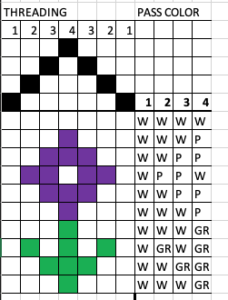 |
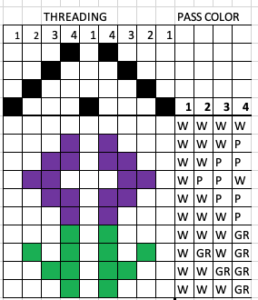 |
| Point Threading | Rosepath Threading |
I picked an image with no color on thread one to help illustrate what happens because blank spaces are easier to see. Adding the extra white thread in the middle causes the image to separate, and look a little empty. Your next thought is that you can now fill the space, I suspect. I choose to add a center spot of yellow to the flower.
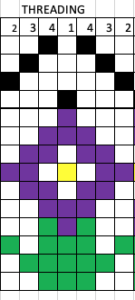 |
This looks like you are just expanding the flower. |
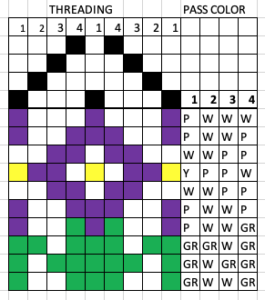 |
You also need to add the same coloring to all threads on shaft 1 |
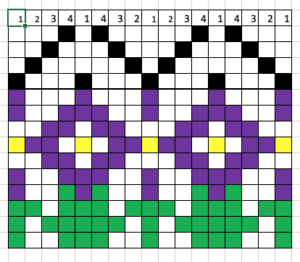
|
This is what the repeat will look like on your fabric. |
Q 2: Also, you have the tieup I think for a sinking shed, I have 2 rising shed looms so I guess my treadling will be 34 41 12 23 should it change for rosepath?
A note in my instructions, mentions that I set up these drafts so that the weaver can weave them face up. Normal treadling sequences would have the weaver making the pattern face down where they can not see it, because it requires less physical effort – moving one shaft versus three at a time.
When working with new weavers, I find that although there are more shafts to lift on each throw, they get a better feeling for how to control the weave by weaving face up. My instructions have weavers raise all shafts except for the one that they want to have the weft color appear on the top. Its easier to discover an error and repair it this way. When working on a table loom it is a matter of moving levers rather than depressing treadles and therefore the effort is not the issue. If you set up the wrong tie-up you will not see an image on the front of the cloth you will see it on the bottom. Always check both surfaces.
The treadling sequence will not change with Rosepath threading. There will be the same numbers of passes with the same colors of thread.
Q3: if I want a little more space, can I do 44 1 2 3 4 3 2 1 44?”
This translates into: How do I expand boundweave patterns using only 4 shafts?
 |
Here I have repeated the two outermost threads, 1 and 2 |
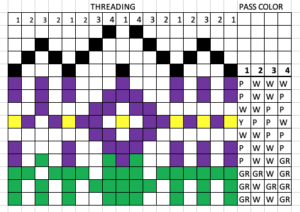 |
The repeat is a point twill from threads 1 to 3 |
I have left you to wonder what does a 44 1 2 3 4 3 2 1 44 pattern look like.
Here is how to find out:
If you have Excel or graph paper start with the pattern in the center, you can copy and paste in Excel.
To get square grids in Excel – Highlight the leftmost corner block in the spreadsheet, it will highlight all of the cells, change the width of the cell to 20, and the height to 20 as well. You can click and drag to resize or use a tool bar to set the property.
Write your proposed expanded threading, now copy the colors from those columns into your new draft.
My turn to ask questions:
One thing to think about, in all of the examples I have provided so far, are there two threads on the same shaft side by side?
What change would you expect to see in your cloth?
Does that change affect the outcome and beauty of the cloth in a good or bad way?
In the examples given so far, have there been any changes in treadling or tie-up?
What have you learned about, threading and figure placement in boundweave from this little exercise?
